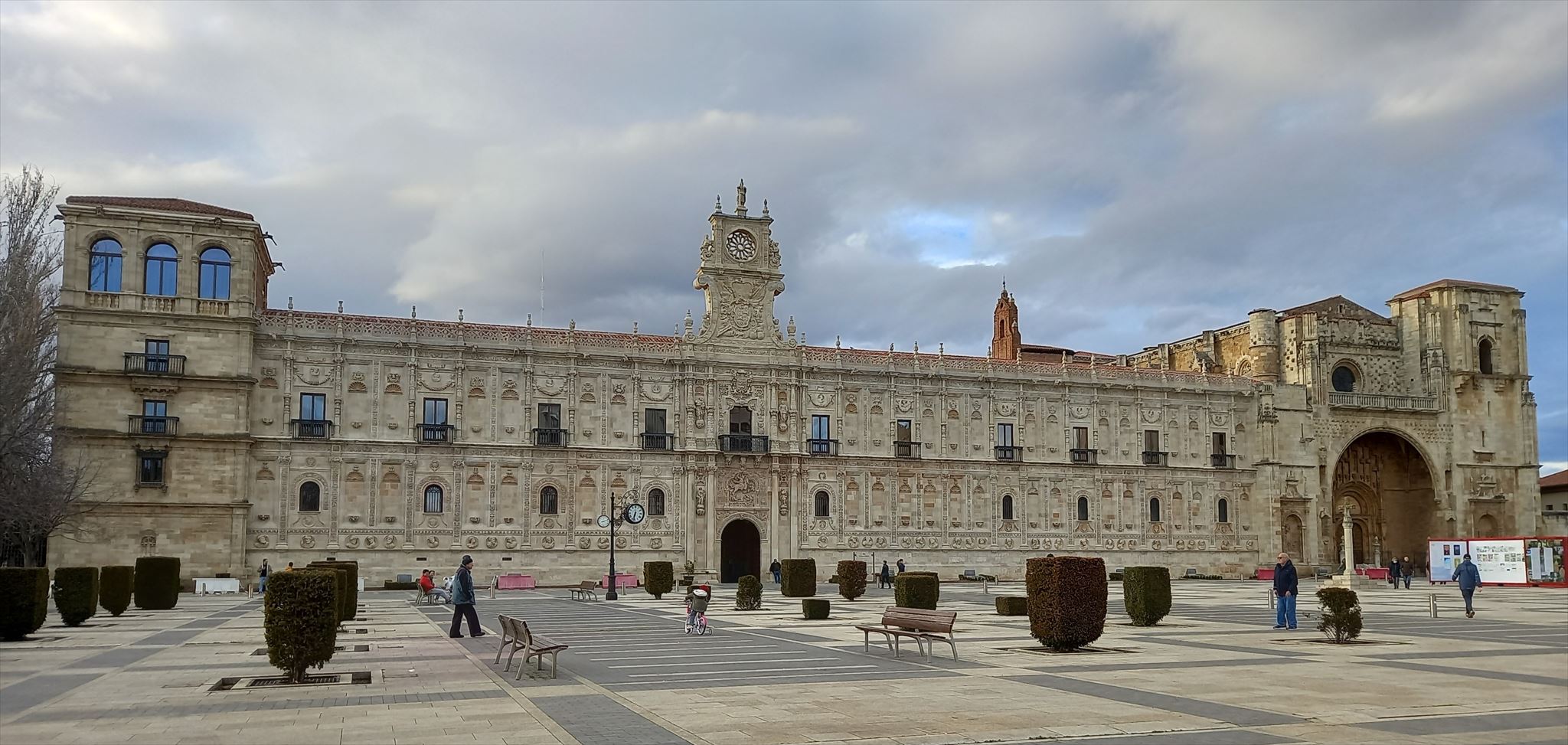-English version below-
ESPAÑOL
Convento de San Marcos de León

Historia
El convento de San Marcos es una de las grandes joyas de la arquitectura de la ciudad española de León, junto con la catedral, la basílica de San Isidoro y la Casa Botines. Se encuentra hoy convertido en parador de turismo de España, además de iglesia consagrada y Museo de León, siendo uno de los monumentos más importantes del Renacimiento español.
El antiguo hospital de peregrinos
Los orígenes de este edificio se encuentran en el siglo XII, cuando en tiempos de Alfonso VII de León, su hermana, la infanta Sancha Raimúndez, realizó una donación en julio de 1152 destinada a la construcción de un modesto edificio a las afueras de la ciudad amurallada y a orillas del río Bernesga, en el cual pudieran hospedarse «los pobres de Cristo», convirtiéndose así en un templo-hospital para refugio de los peregrinos que realizaban el Camino de Santiago. Asimismo, el edificio fue la residencia principal de la Orden de Santiago en el reino de León. En 1176 Pedro Fernández de Castro, el primer maestre de la Orden de Santiago, fue elegido como primer prior, y en 1184 recibió sepultura en su iglesia.
Historia de la construcción
En el siglo XVI, el edificio medieval se hallaba en mal estado, por lo que se derribó y se realizó una nueva obra gracias a una donación de Fernando el Católico en 1514. Los arquitectos designados para esta obra fueron: Juan de Orozco (iglesia), Martín de Villarreal (fachada) y Juan de Badajoz el Mozo (claustro y sacristía). Sin embargo, hasta bien entrado el reinado de Carlos I no se inició la nueva obra. Se sabe que en 1537 se construyó el lienzo de la fachada principal del convento desde la entrada hasta la iglesia, que fue consagrada en 1541. En los años siguientes, Orozco construye las esculturas de la fachada, se realiza el coro, y en 1549, Juan de Badajoz terminó la sacristía. Los trabajos fueron suspendidos en 1566 por el traslado de la comunidad a Calera y luego a Mérida, pero el regreso de los frailes a San Marcos en 1602 dio impulso a la continuación de la obra. En 1615 se construyó la escalera y en 1679 se concluye la parte del claustro que aún faltaba. Finalmente, entre 1711 y 1715 se realiza una gran ampliación del edificio, levantándose otro lienzo que va desde la entrada principal hacia el río, hasta rematar en la torre palaciega. Este nuevo lienzo imita perfectamente el construido en el siglo XVI, no notándose apenas diferencia artística entre ambas mitades de la fachada.
Desde 1964 el edificio forma parte de la red de Paradores de Turismo, y es conocido por muchos leoneses como Hostal de San Marcos. Es una parada obligatoria en el Camino de Santiago.
Usos del edificio
El edificio ha tenido un gran número de usos a lo largo de su historia, principalmente tras la supresión de su uso como convento en 1836; entre ellos están: instituto de segunda enseñanza, casa de misioneros y corrección de eclesiásticos, escuela de veterinaria, hospital penitenciario, prisión militar.
Campo de concentración de prisioneros republicanos durante la Guerra Civil y la posguerra.
Entre 1936 y 1940 fue uno de los establecimientos represivos más severos y saturados de la España franquista, alcanzando una población reclusa de cerca de 7000 hombres y 300 mujeres. Fue el símbolo de la represión en León y parte de España y se cobró 791 fusilados, 1563 paseados y 598 sin asignar (ejecutados, paseados, muertos en los campos, etc.), además de 15860 prisioneros políticos distribuidos por campos y prisiones leonesas y nacionales. En resumen, miles de personas que pasaron por sus instalaciones, detenidas ilegalmente por el franquismo; muchas de ellas fueron torturadas o sacadas de allí para ser asesinadas y enterradas en fosas comunes, como la del cementerio de Villadangos del Páramo, entre otras.
Fuente: Wikipedia
Sobre el cache
Para registrar este cache como encontrado debes cumplir estos dos requisitos:
1-Pregunta
En las coordenadas iniciales encontrarás una tapa cuadrada de alcantarilla; sobre ella hay un código de letras y números. Debes encontrar los cinco últimos dígitos (XXXXX) y enviarme un mensaje o e-mail con esos dígitos:
EN124-XXXXX
2-Foto
Toma una foto tuya (no es necesario que sea de cara entera) con la fachada del convento al fondo; adjunta la foto en tu registro.
El incumplimiento de cualquiera de estos dos requisitos provocará el borrado de tu registro.
IMPORTANTE: ¡no publiques la respuesta en tu registro!
ENGLISH
Convento de San Marcos de León
History
The former Convento de San Marcos in León, Spain, is today an operating a luxury parador hotel. It also contains a consecrated church and museum, and is one of the most important monuments of the Renaissance in Spain. It is one of the greatest architectural jewels of León, together with the Cathedral, the Basilica of San Isidoro and la Casa Botines. It has a highly ornamental plateresque facade.
The primitive hospital for pilgrims
The origins of this building lie in the twelfth century, in the days of Alfonso VII of León. His sister, the Infanta Sancha of Castile, made a donation in July 1152 to construct a modest building on the outskirts of the walled city, on the banks of the Bernesga river, where "the poor of Christ" could stay. This would be a hospital-temple of shelter for pilgrims travelling the Camino de Santiago. Also, the building was the main residence for the Order of Santiago in the Kingdom of León. In 1176, Pedro Fernandez de Castro, the first maestre of the Order of Santiago was elected as the first prior, and in 1184 he was buried in his church.
History of construction
In the sixteenth century, the medieval building was found to be in poor condition, so it was demolished and a new work was carried out thanks to a grant from Ferdinand the Catholic King in 1514. The architects appointed for this work were: Juan Orozco (church), Martin Villarreal (front facade) and Juan de Badajoz el Mozo (cloister and sacristy). However, the new work was not started until well into the reign of Charles I. It is known that the wall of the main facade of the convent was built in 1537, from the entrance up to the church, and this was consecrated in 1541. In the following years, Orozco constructed the sculptures of the facade, the choir area was completed, and in 1549 Juan de Badajoz finished the sacristy. Work was suspended in 1566 due to the move of the religious community to Calera and then to Mérida, but the return of the friars to San Marcos in 1602 gave impetus to continue the work. In 1615 the staircase was built, and in 1679 was completed the still missing part of the cloister. Finally, between 1711 and 1715 there was a large expansion of the building, with another wall being raised that went from the main entrance to the river, and ending at the palace tower. This new wall perfectly mimics the one built in the sixteenth century, with any artistic difference between the two halves of the facade being barely noticeable.
Since 1964 it has been a hostel belonging to the state-owned Paradores de Turismo, and is also known by locals as Hostal de San Marcos. It is necessary step in the Camino de Santiago.
Uses of the building
The building has have a number of uses along its history, particularly since 1836, after the suppression of its uses as a convent. Those uses include: secondary school, missionary house, veterinary school, hospital or military prison.
Concentration camp for republican prisoners during the Spanish Civil War and post-war
The darkest period in the monastery of San Marcos's five centuries of history is concentrated in just four years. During the course of the Spanish Civil War cells, rooms, stables, cloisters, church, choir, museum and every fast corner of the building were transformed into impromptu dungeons or jailers' offices. Between July 1936 and the end of 1940, up to 7000 men and 300 women were imprisoned at the same time. It is estimated that, over the entire war and the period immediately following, the number of Republican militia members and political prisoners that passed through its cells totaled some 20000. In the province of Leon, around 3000 deaths are recorded due to the Franco's repression, and a good number of these came from the dungeons of San Marcos.
About the cache
To log this cache you have to fulfil these two requirements:
1-Question
At GZ you will find a square iron manhole cover. There is a written code on it, including letters and numbers. You have to find the last five digits (XXXXX); message or e-mail them to me:
EN124-XXXXX
2-Photo
Take a photo of yourself (entire face is not required to be in the photo) with the facade of convent as a background; post the photo in your log.
All logs without the correct photo & e-mailed answer will be deleted.
IMPORTANT: please, do not post the answer in your log!
← o 0 o →
Virtual Rewards 3.0 – 2022-2023
-Este cache virtual es parte de un lanzamiento limitado de virtuales realizado entre el 1 de marzo de 2022 y 1 de marzo de 2023. Solo 4.000 propietarios de caches tuvieron la oportunidad de ocultar una cache virtual. Para más información sobre Recompensas virtuales 3.0 en el Blog de Geocaching.
-This Virtual Cache is part of a limited release of Virtuals created between March 1, 2022 and March 1, 2023. Only 4,000 cache owners were given the opportunity to hide a Virtual Cache. Learn more about Virtual Rewards 3.0 on the Geocaching Blog.
